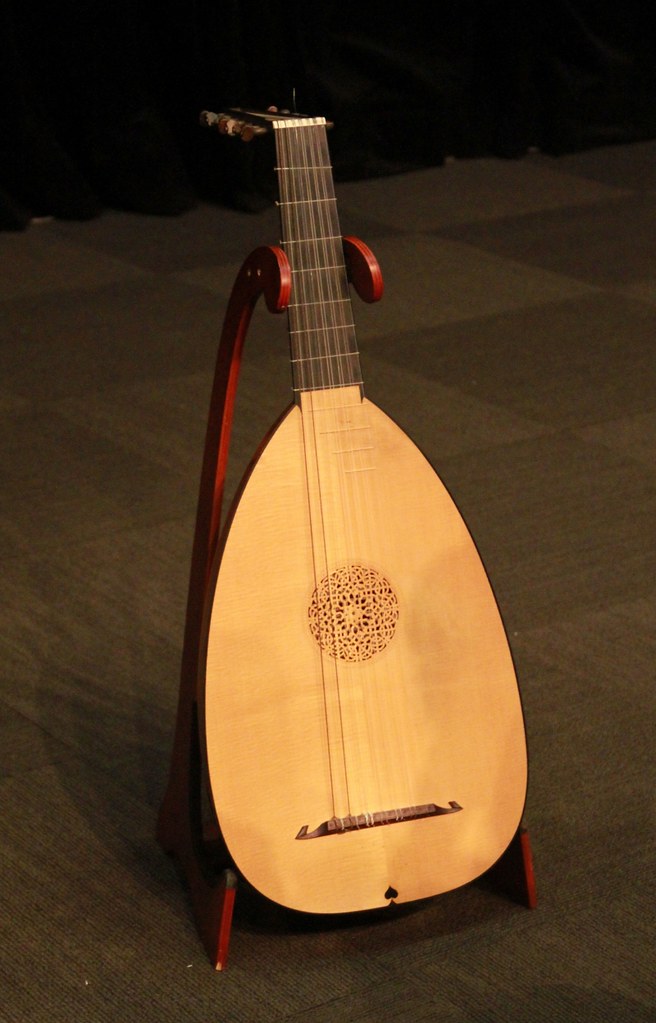Hurdy gurdy, sackbut, serpent, Crumhorn! Am I even speaking English? Why yes, very old English indeed. Keep reading to learn about a plethora of historical Medieval instruments!
The Big Three
The Medieval era took place from approximately 500-1400, literally hundreds of years of music! However, there is very little written music for these instruments that still remains. Most of what historians do have on paper is vocal. Luckily, we still know of the instruments themselves that were played in this era. Let’s learn more!
The three main types of instruments that were played in this time period were strings, flutes, and drums. Some performers even played the flute and a drum at the same time. Check out part of a recital, where French musician Pierre Hamon has created a Medieval-inspired piece for flute and tabor.
As a general rule, most Medieval instruments were classified as either ‘bas’ or ‘haut’. These words originate from French, with the word ‘bas’ means low, and ‘haut’ means high. Let’s talk about the big three more in depth.
Medieval Wind Instruments
Side blown flutes and vertical flutes (such as recorders) were both around during this time period.
Here’s a short list of common vertical flutes one would have found in this era:
- Recorders
- Flageolets
- Pan Pipes
When people think of recorders today, they often picture the inexpensive plastic instruments students might come home within Elementary school. While these are great learning tools, it’s definitely not what was around in the middle ages. Recorders were primarily made of various types of wood, such as birch.
The flageolet is a small vertical flute. Its name comes from the old French word for ‘pipe.' Unlike the recorder, this instrument has two back thumbholes, and often was made with an ivory mouthpiece. It looks quite like a small, oddly-shaped oboe. In the early 18th century, it actually filled the space of the piccolo in the orchestra.
The syrinx, or pan pipes, were played during this time period as well. They’re made with a series of closed wooden tubes that gradually increase in length. This instrument most likely spread across Greece and into parts of Europe during the early Medieval times.

There were many other kinds of flutes and duct flutes (recorder-like instruments) that were used during this period. If you’d like to hear from a recorder player about more medieval music history, check out this video by Sarah.
Medieval String Instruments
Strings were a vital part of music in the middle ages. You might have heard about these medieval string instruments already:
- Dulcimer
- Mandolin
- Lute
The dulcimer was first developed in the late medieval ages. Rather than being plucked like some of the dulcimers we have today, the oldest dulcimers were called ‘hammer dulcimers’. Just like it sounds, they were played by striking tiny hammers to the strings.

The lute is a type of plucked string instrument with a sound hole and a deep back. The mandolin is actually in the lute family. Before the mandolin, there was the mandore. The mandore was an early medieval instrument that had 4 gut strings. So, to clear everything up, the lute led to the mandore, which led to the mandolin.
Don’t have a lute, but still want to serenade your sweetheart with its music? Here’s a great book of German lute music that has been transcripted for the guitar.
Strings You Might Not Know
These string instruments aren’t quite as well-known today. Let’s look at some of them. The:
- Hurdy gurdy
- Viol
- Zither
Haven’t heard of a hurdy gurdy yet? A hurdy gurdy is a drone instrument. It sits flat on your lap, and when you turn the handle, it activates the wheel mechanisms inside the instrument, and tones are produced. The left hand typically plays the keys while your right hand works the handle.

A viol is an instrument that has frets and a hollow body, and it is played by a bow. If you imagine a smaller viol, it would look a lot like a violin, but with frets. Viols are the predecessors to what they play in modern orchestras today. They might also be called viola de gamba, or just gamba.
Other key differences between the viol and violin are that the viol was made with thinner wood, and had a larger chamber, making it both lighter and more resonant. Viols did not come in one size, but were more of an instrument family.
Zithers
The zither is not just one instrument either, but rather, a family of instruments. A zither is any stringed instrument, with a soundboard that is horizontal. It can be played with a pick or with your fingers. We already talked about a few zithers earlier, like the lute and the mandolin. Some other instruments that can be classified as Medievil zithers are the:
- Psaltery
- Gittern
- Moorish Guitar
The psaltery was similar to the dulcimer, except for the fact that it was plucked with fingers or a plectrum (a type of pick), making it a Zither. The Gittern was a small lute-type instrument, and was played with a quill. The Moorish guitar was an instrument that spread widely from 711-1492. While still a lute-type instrument, this one differed due to its headstock bent backwards into a sickle. Much like with the flutes, there are many, many different types.
Medieval Percussion Instruments
Medieval drums were essential to the middle ages. Percussion that was commonly played during this time includes the:
- Tabor
- Finger Cymbals
- Tambourine
Tabors were by far the most popular drum in this period. Tabor is Latin for ‘drum.' Tabors in medieval times were portable, and played with the hand or drumsticks. These drums typically had two heads, and a rope that tightened then. Refer to the prior video to watch a drum being played the way people in medieval times would have played it!

Finger cymbals and tambourines were already around during these times. Finger cymbals have been around for a very long time, and were handcrafted by metalworkers, usually out of brass. Tambourines were sometimes square, and were played by minstrels and entertainers.
So why were Medieval percussion instruments so important in this time period? Well, that’s because...
It’s all about dancing!
Music was flourishing during this period, because of all of the dances. Both royals and peasants alike needed instrumentalists for their get-togethers.
One popular dance instrument accompanied was called the Estampie, which is a French dance and musical form. The Estampie is typically played in three. A famous music theorist from this time period, named Jean de Grouchy, once called the Estampie ‘irregular and complicated.’ However, I think his last name speaks for itself... the music is actually very beautiful and not irregular at all.
More Medieval Winds
We wouldn’t have a complete article if we didn’t talk about these medieval wind instruments. Developments of some of these ancient brass instruments are the reason why we have the trumpet, trombone, and many others today. Here are the names of some other notable instruments:
- Crumhorn
- Sackbut
- Serpent
- Buisine
The crumhorn was a double-reeded woodwind instrument. It was made of wood, and had a cylindrical bore. It gets its name from the English word Krummhorn, which means ‘crooked’.
The sackbut, serpent, and buisine are all members of the brass family. Most of the instruments in the brass family were relatively rare, as they were reserved almost exclusively for performances for royalty. The sackbut was an early trombone, which featured a slide. The serpent was a spiraling, snake-shaped bass instrument, which had side keys like a woodwind, but a brass-style mouthpiece.
The buisine was actually a type of medieval trumpet. Unlike some of these other brass instruments, they weren't necessarily reserved for the rich; they were more common. The buisine was a six-foot long, metal medieval trumpet.
Odd Instruments
Let’s hear about some wacky instruments made from animal parts!
The bladderpipe was an instrument that predates the bagpipe. The bladderpipe was an instrument made with a reed inside an animal bladder. The player would blow into the mouthpieces, and the air would travel from the mouthpiece to the tube, into the reed/bladder where it would resonate.
Unlike the Medieval brass family, the bladderpipe was said to be an instrument that was played by the poor. It’s reported to sound like ‘a very loud crumhorn’
The gemshorn, was a flute made from the horn of a goat, or chamois (a type of goat-antelope). It’s technically part of the ocarina family. Not to worry though, if the gemshorn is the instrument for you, they now make them from domesticated cattle horns, and from synthetic materials.
Performances Today
Medieval music hasn’t just gone by the wayside. There are quite a few recorder ensembles and artists out there performing in this style! I wanted to take a moment to share some Medieval-themed music with you, by the artist Hildegard Von Blingin’. This might be what Lady Gaga’s ‘Bad Romance’ would’ve sounded like in the year 1200 or so!
The university I went to even had a Music Collegium ensemble, where students could learn to play the lute and different medieval winds. If you’re still in college, I recommend checking out what resources are available to you!
Wrap-Up
To close, the medieval times were rich in both art, dance, and music. They all blended together to create a mesmerizing period of creativity, and ingenuity (especially when it came to developing instruments). I hope you’ve found this article on Medieval musical instruments to be informative, and that it’s inspired you to delve deeper into the ocean that is music history!
Photo by knackeredhack | CC BY






